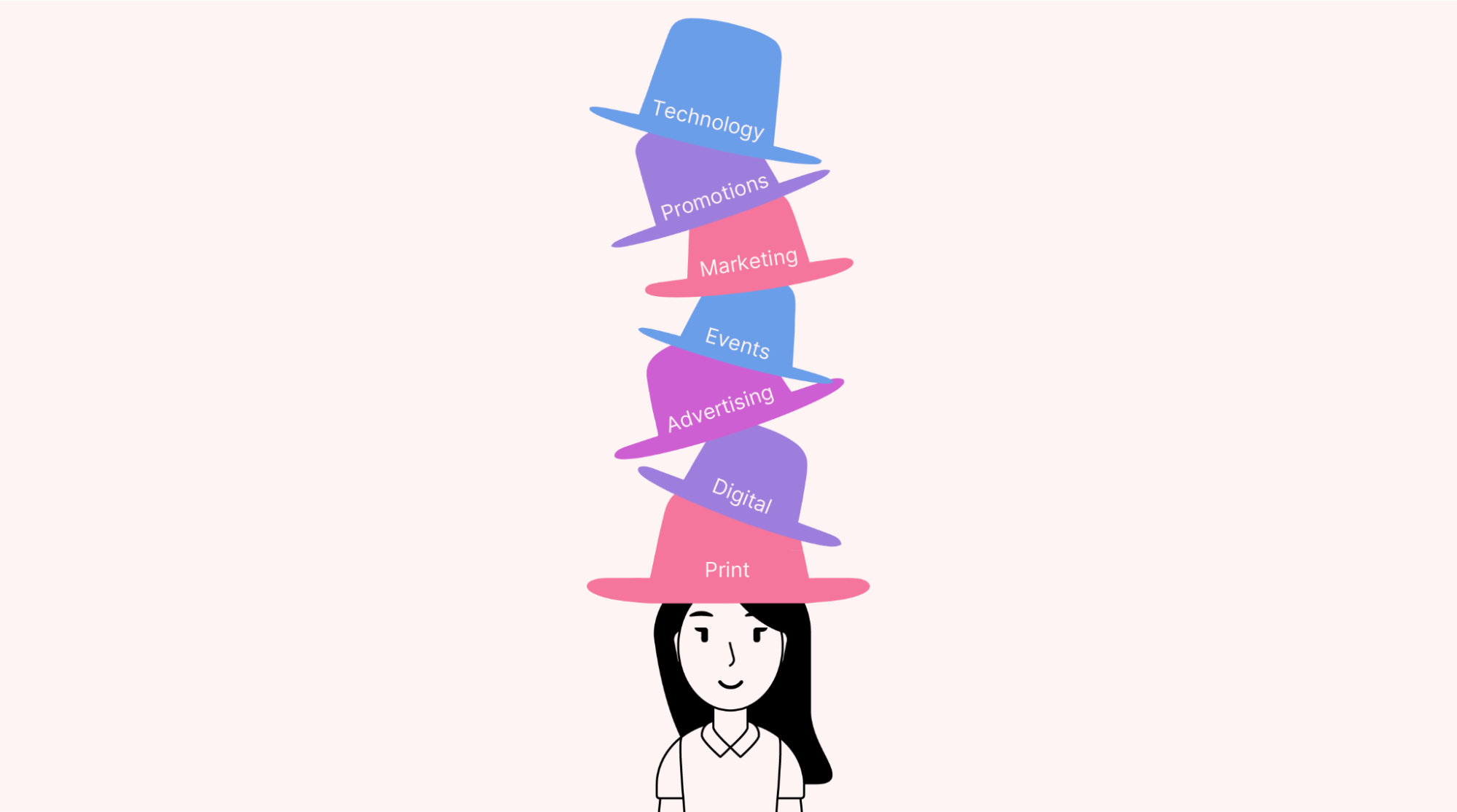Creative professionals make some of the most amazing things but sometimes miss the mark.
Creative project tasks can get caught up in the pipeline without structure in the creative process. Creatives often seek perfection, while clients (at times) want some form of progress. It’s a tricky balancing act.
The creative project journey involves a unique blend of art and organization. In this article, we’ll examine this unique blend and how you can apply project management approaches and best practices to your creative processes and projects.
What is project management for creatives?
Project management for creatives is the process of managing creative teams and clients using project management principles and practices. These provide a framework to control creative projects from initiation to final project deliverables.
Project management for creatives is the process of managing creative teams and clients using project management principles and practices. These provide a framework to control creative projects from initiation to final project deliverables.
Creative teams have many roles, each unique and often highly specialized. An on-site or virtual creative team may include artists, graphic designers, copywriters, search engine optimization (SEO) specialists, etc.
Creative projects typically support marketing, sales, customer service, and public relations functions.
Entrepreneurs or small business owners sometimes take on the duties of a creative director. Alternatively, they might contract out marketing initiatives to a creative firm with specialist knowledge. However, anytime you're planning a marketing campaign, ad, blog post, video, or other creative design project that uses creative skills, then you're essentially a creative manager.
Creative project management vs. traditional project management
Creativity is nearly impossible to measure, but has brought us things like music, books, and beautiful architecture.
Creative output thrives in an environment where innovation is encouraged. Unlike conventional projects that follow established procedures, creative projects seek novel solutions. This is why creative projects inherently involve risk. There's no blueprint, so iteration is key.
Traditional project managers rely heavily on data and metrics to inform decisions and planning. Creative project managers, on the other hand, often begin with inspiration and vision. They then harness that initial spark and nurture it through the entire project lifecycle.
Key principles and characteristics of successful creative project management
Traditional project management principles and methodologies work just as well for creative tasks and projects, maybe with some tweaks for custom workflows.
While we can't review all of them, we'll focus on the three most impactful practices creative teams should apply.
Keep customers first
Here's the big rub: sometimes, creative teams can be too creative (because, as the adage goes, you can't rush creativity), which often leads to delays in the entire project. Or the creative team, in the name of creativity, might come up with something that doesn't meet the exact requirements of the client.
Say you own a marketing agency, and your video editor (John) decided to change the layout of a video because he thinks it flows better. He might be right, but for a client with strict requirements and no time to waste, that could be an issue.
This is why the most important principle of creative project management is always putting the customer's needs first. The cost of not doing the video per the customer's expectations is the possibility of losing the client. No bueno.
One way to face this head-on is to continuously communicate with the customer.
If the video editor thinks that a new layout will add more value, then, first, approach the client and discuss. Always put client expectations first and creativity second.
Go Agile
Agile frameworks work well in creative environments. Why? Because they use collaboration and adaptability to create a work culture where innovation can thrive.
Agile project teams focus on delivering iterations and then adjusting the next iteration based on feedback from the client. This process puts the customer's needs first.
John can use the feedback in the agile feedback loop to refine the video until the customer is happy.
Creative clients (like most clients) sometimes have changing requirements. First, they might want the video to have a smooth soundtrack, but then they ask for a more upbeat one. Since agile project work is delivered in iterations, John can easily work this change into his plans.
Some other advantages of Agile frameworks for creative teams are:
- A flexible approach to project timelines.
- Incorporating contingency planning and risk management into workflows.
- An emphasis on open communication among team members.
- A focus on managing creative assets and resource allocation.
Multi-disciplined
Creative project managers wear many hats with their project teams. Each of these roles is key to success:
- They should understand how the product works for each creative output
- They should have the creative knowledge to be able to jump in and get their hands dirty
- They also need to support their team and push them to deliver their best
- Lastly, they need to apply the practice and principles we just went over
For our video production firm, you, as the de facto project manager, need baseline knowledge about editing and capturing videos and managing your team and clients.
Challenges of creative project management
Not everything can be roses, right? The following challenges can have a significant impact on a project (creative or not).
Managing expectations
Creative projects are different from bricks and bytes products. And clients on creative projects can be different. You might even think they tend to have unrealistic expectations.
For example, our video agency has a new client who is expecting a Hollywood movie production but with a Facebook ad budget.
 |
The key to managing customer and stakeholder expectations is to be transparent (and honest) from the get-go. Tell the client that if they want a Hollywood-scale production, they'll need to pull in with a Hollywood-sized budget. Once they're on board, keep them (and the entire team) in the loop using the collaboration tools (and communication plan) you have on hand.
Matching outputs with project objectives
A new artist exhibits his work for the first time, and a well-known art critic approaches him. The critic asks the artist, "Would you like to hear my opinion of your work?". "Yes", the artist replies. "It's worthless," says the critic. "I know," the artist says, "but let's hear what it is."
As mentioned before, creative outputs can quickly become too creative (or fall victim to their own creative ignorance, like the artist). The creative project manager needs to manage the team in the context of the project scope. It can be easier to match outputs with your project goals when using an Agile (iterative) approach.
Resourcing
It's a fact that it's much less expensive to keep current creative talent and develop them than to find new talent. It's also better to keep creative teams specialized and small. Why?
You can’t replace one creative team member with another one like you might replace a light bulb. Creative people are unique and have their own ways of thinking about, working on, and approaching projects.
You won't be able to complete the planning of a billboard campaign ten times faster by adding ten times the amount of staff. The same goes for using extra time to address a design issue. Having more people on board can boost creativity, but it also increases the amount of time needed for generating ideas, evaluating them, and managing team members.
As they say, too many chefs spoil the soup.
Top tips for creative project management
Using what we've covered so far can help you steer your creative ship in the right direction. Here are some tips to supercharge your processes (and team).
Use creative tools
Creative team leaders should have basic knowledge of various applications, such as:
- Project management software
- PowerPoint or slideshow applications,
- Graphic design tools
- Video editing software
- Print production methods
- Content management systems (CMS)
- Customer relationship management (CRM) programs
 |
This way, you can pitch in or troubleshoot technical issues when needed.
Centralize the creative project management process
If you're managing more than one person or project, email won't cut it. And, like any project, creative projects can have many plates in the air simultaneously, where it's easy to lose track of what's going on and where.
Instead of trying to keep track of everything in separate systems (or, worse, manually), use a central project management tool (like Motion). Not only can you then manage all your creative processes in one system, but you can also automate things like updates and notifications.
And, the icing on the cake, with a central project management system, you can track all the work from start to end.
Use Motion as your creative project management tool
With Motion's AI task manager, you simply create the creative project, the task list, deadlines, and priorities, and Motion will do the rest. It can even populate each person's schedule with their work (optimized for the best time and dates).
 |
The best part is that Motion uses AI to learn each team member's output, strengths, and preferences to optimize their schedules for when they're most productive.
For example, if some video editors work best in the mornings, then Motion can plan their day accordingly.
Motion features a Kanban board, a great visual project management tool for creative agencies. Motion's Kanban board works alongside the task manager to optimize workflow and can help you manage tasks throughout their various stages.
Motion also has a meeting assistant to help you manage remote creative teams, including scheduling. The meeting assistant integrates with many 3rd-party calendars and can then find the best time slots for the entire team (and lock those in).
Sign up for your 7-day free trial.





